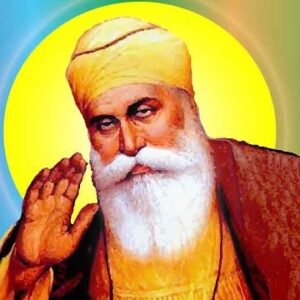Guru Nanak was an Indian saint who created Sikhism and became the first of the Sikh Gurus. A visionary and a tremendous soul, he was an original spiritual thinker. His religious concepts rely on both Hindu and Islamic thoughts, but are also unique in their own way. Born into a Hindu family in 15th century India, he started demonstrating evidence of his greatness early on in boyhood. Even as a youngster he used to spend long hours in meditation and was extremely spiritual. He questioned the pointless rituals his family conducted in the name of religion and refused to engage in them. His intense religiosity frightened his parents and they sought to interest him in practical issues. The kind-hearted little boy dispersed his father’s money to the poor and needy thereby greatly angering his pragmatic father who hoped that his son would one day become a businessman. Even an arranged marriage at an early age did not prevent Nanak from traveling further on the spiritual path. Eventually he went on to develop Sikhism, a monotheistic religion that preaches the concept of the oneness of God. He journeyed far and wide, mostly on foot, conveying the message of oneness of God who dwells in all living beings.
Childhood & Adolescence
Guru Nanak was born into a Hindu household on 15 April 1469 at Ri Bhoi K Talva (modern-day Nankana Sahib, Punjab, Pakistan), near Lahore. Mehta Kalu, his father, and Mata Tripta, his mother, were merchants. His father was the village’s patwari (accountant). He had one elder sister, Bebe Nanaki, with whom he shared a special relationship.
He began demonstrating his brilliance at a young age. When he was five years old, he had an interest in spirituality and divine matters.
He began attending school at the age of seven. According to legend, he explained the symbolism of the initial letter of the Persian alphabet, which resembles the mathematical equivalent of one, to represent God’s unity or oneness.
When he was 11 years old, his father arranged for him to participate in the sacred thread ceremony, a Hindu rite that symbolizes man’s link to God. However, the kid rebelled and refused to engage in the rite, believing it to be worthless.When he reached the appropriate age, his father instructed him to pasture cattle. However, instead of watching the cattle, he would enter contemplative trances and get himself into mischief due to his negligence. This infuriated his father.
Even as a small child, he was very spiritual and philosophical, and he condemned idol worship. He also rejected the Hindu caste system. Despite being born into a Hindu family, he mingled with Muslims and had an interest in both faiths’ theological books.His father attempted to entice Nanak into business and provided him with funds for purchases. Rather than purchasing the resources necessary for the business, Nanak spent the full sum on feeding the poor and hungry.
Later the Decades
When Guru Nanak was roughly sixteen years old, he began working for Daulat Khan Lodi, who also employed his brother-in-law. This was a watershed moment in his life, as he would later make repeated references to the governmental structure in his hymns.He did admirably in his career since he was a diligent and sincere employee. Additionally, he demonstrated a high level of kindness and generosity. Despite the fact that he was now a married man and parent, he remained focused on his quest for spiritual truth.
He established acquainted with Mardana, a Muslim minstrel with whom he used to worship and contemplate. He went to the Kali Bein or Black River with Mardana one morning to bathe. He stepped into the river and vanished beneath the surface. He was nowhere to be seen, and everyone assumed he had drowned in the river.Three days later, he came suddenly out of the river and informed everyone that he had been brought to God’s court. He was spiritually reawakened and profoundly enlightened as a result of this occurrence. From this time forward, he was referred to as “Guru Nanak.”
He quickly lost interest in worldly matters such as family and work, and resigned from his employment. He left his wife and children in the care of his parents and explained to them that God had called him to convey His divine word and that he needed to follow the Almighty’s will.Thus, he formed Sikhism, a religion that promotes the principle of human equality and opposes discrimination on the basis of caste, creed, or gender. Sikhism’s basic message is the concept of God’s oneness.
He traveled extensively with Mardana, spreading the divine message of peace and love to all of humanity. Although there are no precise descriptions of his travels, it is estimated that he conducted at least four significant excursions totaling more than 28,000 kilometers between 1500 and 1524.After his lengthy travels, he returned home and lived in Kartarpur, where he maintained his ministry till his death. He nominated his disciple Bhai Lehna as his successor near the end of his life. After Guru Nanak’s death, Lehna was renamed “Angad” and proclaimed as Guru Angad, the second Sikh Guru.
His Significant Works
Guru Nanak established Sikhism, which has grown to be the world’s fifth biggest organized religion, with around 30 million devotees. He also founded the Langar, or communal kitchen, to show the need of sharing and equality for all people.
Personal History and Legacies
On 24 September 1487, Guru Nanak married Sulakkhani, the daughter of Ml Chand and Chando R. Sri Chand and Lakhmi Chand were the couple’s two sons.He died in Kartarpur on 22 September 1539, at the age of 70.
Estimated Net Worth
Guru Nanak is one of the most wealthy religious leaders in the world. Guru Nanak is also included in the list of notable persons born on April 15 and the list of Pakistan’s wealthiest celebrities. Guru Nanak’s net worth is estimated to be at $1.5 million, based on our analysis of Forbes, IMDb, Wikipedia, and other internet sources.


